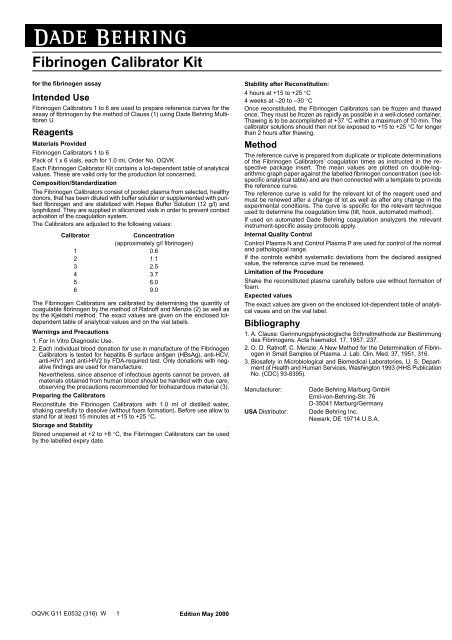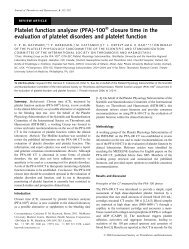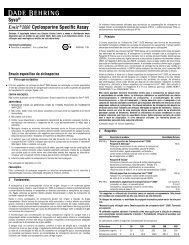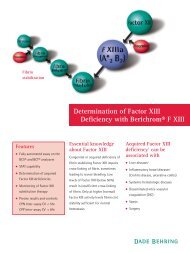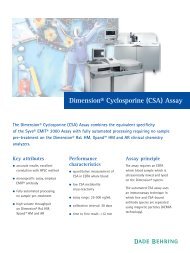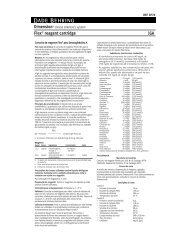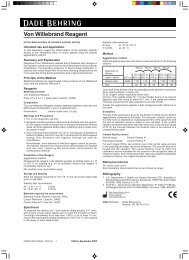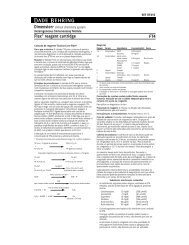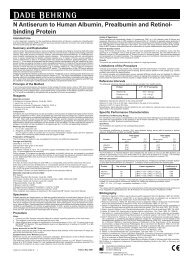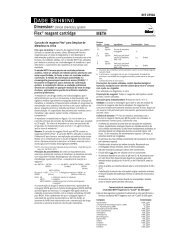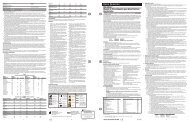OQVK G11 E0532 1.KA - Medcorp
OQVK G11 E0532 1.KA - Medcorp
OQVK G11 E0532 1.KA - Medcorp
You also want an ePaper? Increase the reach of your titles
YUMPU automatically turns print PDFs into web optimized ePapers that Google loves.
Fibrinogen Calibrator Kit<br />
for the fibrinogen assay<br />
Intended Use<br />
Fibrinogen Calibrators 1 to 6 are used to prepare reference curves for the<br />
assay of fibrinogen by the method of Clauss (1) using Dade Behring Multifibren<br />
U.<br />
Reagents<br />
Materials Provided<br />
Fibrinogen Calibrators 1 to 6<br />
Pack of 1 x 6 vials, each for 1.0 ml, Order No. <strong>OQVK</strong><br />
Each Fibrinogen Calibrator Kit contains a lot-dependent table of analytical<br />
values. These are valid only for the production lot concerned.<br />
Composition/Standardization<br />
The Fibrinogen Calibrators consist of pooled plasma from selected, healthy<br />
donors, that has been diluted with buffer solution or supplemented with purified<br />
fibrinogen and are stabilized with Hepes Buffer Solution (12 g/l) and<br />
lyophilized. They are supplied in siliconized vials in order to prevent contact<br />
activation of the coagulation system.<br />
The Calibrators are adjusted to the following values:<br />
Calibrator<br />
Concentration<br />
(approximately g/l fibrinogen)<br />
1 0.6<br />
2 1.1<br />
3 2.5<br />
4 3.7<br />
5 6.0<br />
6 9.0<br />
The Fibrinogen Calibrators are calibrated by determining the quantity of<br />
coagulable fibrinogen by the method of Ratnoff and Menzie (2) as well as<br />
by the Kjeldahl method. The exact values are given on the enclosed lotdependent<br />
table of analytical values and on the vial labels.<br />
Warnings and Precautions<br />
1. For In Vitro Diagnostic Use.<br />
2. Each individual blood donation for use in manufacture of the Fibrinogen<br />
Calibrators is tested for hepatitis B surface antigen (HBsAg), anti-HCV,<br />
anti-HIV1 and anti-HIV2 by FDA-required test. Only donations with negative<br />
findings are used for manufacture.<br />
Nevertheless, since absence of infectious agents cannot be proven, all<br />
materials obtained from human blood should be handled with due care,<br />
observing the precautions recommended for biohazardous material (3).<br />
Preparing the Calibrators<br />
Reconstitute the Fibrinogen Calibrators with 1.0 ml of distilled water,<br />
shaking carefully to dissolve (without foam formation). Before use allow to<br />
stand for at least 15 minutes at +15 to +25 °C.<br />
Storage and Stability<br />
Stored unopened at +2 to +8 °C, the Fibrinogen Calibrators can be used<br />
by the labelled expiry date.<br />
Stability after Reconstitution:<br />
4 hours at +15 to +25 °C<br />
4 weeks at –20 to –30 °C<br />
Once reconstituted, the Fibrinogen Calibrators can be frozen and thawed<br />
once. They must be frozen as rapidly as possible in a well-closed container.<br />
Thawing is to be accomplished at +37 °C within a maximum of 10 min. The<br />
calibrator solutions should then not be exposed to +15 to +25 °C for longer<br />
than 2 hours after thawing.<br />
Method<br />
The reference curve is prepared from duplicate or triplicate determinations<br />
of the Fibrinogen Calibrators' coagulation times as instructed in the respective<br />
package insert. The mean values are plotted on double-logarithmic<br />
graph paper against the labelled fibrinogen concentration (see lotspecific<br />
analytical table) and are then connected with a template to provide<br />
the reference curve.<br />
The reference curve is valid for the relevant lot of the reagent used and<br />
must be renewed after a change of lot as well as after any change in the<br />
experimental conditions. The curve is specific for the relevant technique<br />
used to determine the coagulation time (tilt, hook, automated method).<br />
If used on automated Dade Behring coagulation analyzers the relevant<br />
instrument-specific assay protocols apply.<br />
Internal Quality Control<br />
Control Plasma N and Control Plasma P are used for control of the normal<br />
and pathological range.<br />
If the controls exhibit systematic deviations from the declared assigned<br />
value, the reference curve must be renewed.<br />
Limitation of the Procedure<br />
Shake the reconstituted plasma carefully before use without formation of<br />
foam.<br />
Expected values<br />
The exact values are given on the enclosed lot-dependent table of analytical<br />
vaues and on the vial label.<br />
Bibliography<br />
1. A. Clauss: Gerinnungsphysiologische Schnellmethode zur Bestimmung<br />
des Fibrinogens. Acta haematol. 17, 1957, 237.<br />
2. O. D. Ratnoff, C. Menzie; A New Method for the Determination of Fibrinogen<br />
in Small Samples of Plasma. J. Lab. Clin. Med. 37, 1951, 316.<br />
3. Biosafety in Microbiological and Biomedical Laboratories, U. S. Department<br />
of Health and Human Services, Washington 1993 (HHS Publication<br />
No. (CDC) 93-8395).<br />
Manufacturer:<br />
USA Distributor:<br />
Dade Behring Marburg GmbH<br />
Emil-von-Behring-Str. 76<br />
D-35041 Marburg/Germany<br />
Dade Behring Inc.<br />
Newark, DE 19714 U.S.A.<br />
<strong>OQVK</strong> <strong>G11</strong> <strong>E0532</strong> (316) W 1 Edition May 2000
Fibrinogen Kalibrator Kit<br />
für die Fibrinogen-Bestimmung<br />
Anwendungsbereich<br />
Die Fibrinogen-Kalibratoren 1 bis 6 dienen zur Erstellung von Bezugskurven<br />
für die Fibrinogen-Bestimmung nach Clauss (1) mit Multifibren U der<br />
Dade Behring Marburg GmbH.<br />
Reagenzien<br />
Inhalt der Handelspackung<br />
Fibrinogen Kalibratoren 1 bis 6<br />
Packung mit 1 x 6 Flaschen für je 1,0 ml, Bestell Nr. <strong>OQVK</strong><br />
Jede Packung Fibrinogen Kalibrator Kit enthält eine chargenabhängige<br />
Tabelle der Analysenwerte. Sie gelten nur für die betreffende Herstellungscharge.<br />
Zusammensetzung/Standardisierung<br />
Die Fibrinogen-Kalibratoren werden, ausgehend von einem Mischplasma<br />
von ausgewählten, gesunden Spendern, durch Verdünnung mit Pufferlösung<br />
bzw. durch Aufstocken mit gereinigtem Human-Fibrinogen hergestellt.<br />
Sie sind mit Hepes-Pufferlösung (12 g/l) stabilisiert und lyophilisiert.<br />
Zur Vermeidung einer Kontaktaktivierung des Gerinnungssystems werden<br />
silikonisierte Fläschchen verwendet.<br />
Die Kalibratoren werden auf folgende Werte eingestellt:<br />
Kalibrator<br />
Konzentration<br />
(ca. g/l Fibrinogen)<br />
1 0,6<br />
2 1,1<br />
3 2,5<br />
4 3,7<br />
5 6,0<br />
6 9,0<br />
Die Fibrinogen-Kalibratoren werden durch Bestimmung des gerinnbaren<br />
Fibrinogens nach der Methode von Ratnoff und Menzie (2), sowie nach<br />
Kjeldahl kalibriert. Der jeweilige genaue Wert ist chargenabhängig in der<br />
beiliegenden Wertetabelle und auf dem Flaschenetikett angegeben.<br />
Warnungen und Vorsichtsmaßnahmen<br />
1. Nur zur Anwendung als In-vitro-Diagnosticum.<br />
2. Jede individuelle Blutspende, die zur Herstellung der Fibrinogen-Kalibratoren<br />
vorgesehen ist, wird auf Hepatitis Bs-Antigen, auf Anti-HCV,<br />
auf Anti-HIV 1 und auf Anti-HIV 2 untersucht. Für die Herstellung werden<br />
nur Spenden mit negativem Befund verwendet.<br />
Unabhängig davon sollten alle aus menschlichem Blut gewonnenen<br />
Materialien wegen nie auszuschließender Gefährdung durch Krankheitserreger<br />
mit angemessener Sorgfalt unter Einhaltung der bei Biogefährdung<br />
empfohlenen Sicherheitsmaßnahmen gehandhabt werden<br />
(3).<br />
Vorbereitung der Kalibratoren<br />
Die Fibrinogen-Kalibratoren werden mit 1,0 ml dest. Wasser unter vorsichtigem<br />
Schütteln (ohne Schaumbildung) rekonstituiert. Vor Gebrauch mindestens<br />
15 min bei +15 bis +25 °C stehenlassen.<br />
Haltbarkeit und Lagerungsbedingungen<br />
Die Fibrinogen-Kalibratoren sind ungeöffnet bei +2 bis +8 °C zu lagern und<br />
bis zu dem auf dem Etikett angegebenen Datum verwendbar.<br />
Haltbarkeit nach Rekonstitution:<br />
bei +15 bis +25 °C 4 Stunden<br />
bei –20 bis –30 °C 4 Wochen<br />
Die Fibrinogen-Kalibratoren können nach Rekonstitution einmal eingefroren<br />
und wieder aufgetaut werden. Sie müssen gut verschlossen und möglichst<br />
schnell eingefroren werden. Das Auftauen ist bei +37 °C in max. 10<br />
min zu vollziehen. Die Kalibratorlösungen sollen nach dem Auftauen nicht<br />
länger als 2 Stunden bei +15 bis +25 °C stehen.<br />
Methode<br />
Zur Erstellung der Bezugskurve werden die Gerinnungszeiten der Fibrinogen-Kalibratoren<br />
nach Anweisung der jeweiligen Packungsbeilage in Doppel-<br />
oder Dreifachbestimmung gemessen. Die Mittelwerte werden auf doppellogarithmischem<br />
Papier gegen die deklarierten Fibrinogenkonzentrationen<br />
(s. chargenspezifische Tabelle der Analysenwerte) aufgetragen und<br />
durch einen Kurvenzug verbunden.<br />
Die Bezugskurve gilt für die jeweilige Charge des verwendeten Reagenzes<br />
und muß bei Wechsel der Charge sowie bei jeder Änderung der experimentellen<br />
Bedingungen neu erstellt werden. Sie ist für die jeweils verwendete<br />
Technik zur Bestimmung der Gerinnungszeit (Kippen, Häkeln,<br />
Automat) spezifisch.<br />
Für den Einsatz auf automatischen Gerinnungsanalyzern von Dade<br />
Behring gelten gerätespezifische Testvorschriften.<br />
Interne Qualitätskontrolle<br />
Kontroll-Plasma N und Kontroll-Plasma P werden zur Kontrolle des Normalbereiches<br />
bzw. des pathologischen Bereiches verwendet.<br />
Bei systematischer Abweichung der Kontrollen vom deklarierten Sollwert<br />
muß die Bezugskurve neu gemessen werden.<br />
Einschränkungen<br />
Die rekonstituierten Plasmen sind vor Gebrauch vorsichtig (ohne Schaumbildung)<br />
zu schütteln.<br />
Erwartete Werte<br />
Die genauen Werte werden in der beiliegenden chargenabhängigen Tabelle<br />
der Analysenwerte, sowie auf dem Flaschenetikett angegeben.<br />
Literatur<br />
1. A. Clauss: Gerinnungsphysiologische Schnellmethode zur Bestimmung<br />
des Fibrinogens. Acta haematol. 17, 1957, 237.<br />
2. O. D. Ratnoff, C. Menzie; A New Method for the Determination of Fibrinogen<br />
in small Samples of Plasma. J. Lab. Clin. Med. 37, 1951, 316.<br />
3. Biosafety in Microbiological and Biomedical Laboratories, U. S. Department<br />
of Health and Human Services, Washington 1993 (HHS Publication<br />
No. (CDC) 93-8395).<br />
Hersteller:<br />
Vertreiber Schweiz:<br />
Dade Behring Marburg GmbH<br />
Emil-von-Behring-Str. 76<br />
D-35041 Marburg<br />
Dade Behring AG<br />
Bonnstrasse 9<br />
CH-3186 Düdingen<br />
Schweiz<br />
<strong>OQVK</strong> <strong>G11</strong> <strong>E0532</strong> (316) W 2 Ausgabe Mai 2000
Kit de Calibration<br />
Fibrinogène<br />
Pour le dosage du fibrinogène<br />
Domaine d’utilisation<br />
Les Calibrateurs Fibrinogène 1 à 6 permettent l’établissement de courbes<br />
d’étalonnage pour le dosage du fibrinogène selon Clauss (1), à l’aide du<br />
réactif Multifibren U de Dade Behring.<br />
Réactifs<br />
Conditionnement<br />
Calibrateurs Fibrinogène 1 à 6<br />
Coffret de 6 flacons de 1,0 ml, code <strong>OQVK</strong><br />
Chaque Kit de Calibration Fibrinogène contient un tableau des valeurs<br />
d’analyse spécifique au lot du coffret. Les valeurs indiquées ne valent que<br />
pour ce lot.<br />
Composition/standardisation<br />
Les Calibrateurs Fibrinogène sont obtenus à partir d’un pool de plasmas<br />
provenant de donneurs sélectionnés et sains, dilué avec une solution tampon<br />
ou enrichi avec du fibrinogène humain purifié. Ils sont ensuite stabilisés<br />
avec une solution tampon Hépès (12 g/l) et lyophilisés. Ils sont conditionnés<br />
en flacons siliconés pour éviter toute activation par contact du système<br />
de la coagulation.<br />
Les Calibrateurs sont préparés aux valeurs suivantes :<br />
Calibrateur<br />
Concentration<br />
(env. g/l de fibrinogène)<br />
1 0,6<br />
2 1,1<br />
3 2,5<br />
4 3,7<br />
5 6,0<br />
6 9,0<br />
Les Calibrateurs Fibrinogène sont étalonnés par dosage du fibrinogène<br />
coagulable selon la méthode de Ratnoff et Menzie (2), ainsi que selon<br />
Kjeldahl. La valeur exacte de chaque lot de chacun des Calibrateurs est<br />
indiquée dans le tableau des valeurs joint au coffret ainsi que sur<br />
l’étiquette du flacon.<br />
Mises en garde et précautions d’emploi<br />
1. Réservé à un usage in vitro.<br />
2. Tout don de sang individuel prévu pour la préparation des Calibrateurs<br />
Fibrinogène a été testé vis-à-vis de l’antigène de surface de l’Hépatite<br />
B, de l’anticorps anti-VHC, de l’anticorps anti-VIH 1 et de l’anticorps<br />
anti-VIH 2. Seuls les dons trouvés négatifs ont été utilisés.<br />
Néanmoins, toutes les préparations obtenues à partir de sang humain<br />
doivent être manipulées avec les précautions nécessaires en cas de<br />
risque biologique, dans la mesure où l’on ne peut exclure totalement un<br />
risque d’infection (3).<br />
Préparation des Calibrateurs<br />
Reconstituer les Calibrateurs Fibrinogène avec 1,0 ml d’eau distillée, en<br />
agitant avec précaution (éviter la formation de mousse). Laisser reposer<br />
au moins 15 mn à +15/+25°C avant emploi.<br />
Stabilité et conditions de conservation<br />
Les Calibrateurs Fibrinogène se conservent non ouverts à +2/+8°C, et<br />
peuvent être utilisés jusqu’à la date indiquée sur l’étiquette.<br />
Stabilité après reconstitution :<br />
4 heures à +15/+25°C<br />
4 semaines à –20/–30°C<br />
Une fois reconstitués, les Calibrateurs Fibrinogène peuvent être congelés<br />
une fois. Pour cela, bien fermer le flacon et le congeler le plus rapidement<br />
possible. La décongélation doit se faire en 10 mn maximum à +37°C.<br />
Après décongélation, les solutions de Calibrateurs doivent être utilisées<br />
dans les 2 heures (conservation à +15/+25°C).<br />
Méthode<br />
Pour l’établissement d’une courbe d’étalonnage, déterminer les temps de<br />
coagulation des Calibrateurs Fibrinogène selon le protocole indiqué dans<br />
la fiche technique, en double ou en triple. Reporter sur papier bilogarithmique<br />
les valeurs moyennes en fonction des concentrations de fibrinogène<br />
déclarées (cf. tableau des valeurs d’analyse spécifique au lot), et tracer<br />
la courbe en reliant les points.<br />
La courbe d’étalonnage ainsi obtenue est valable pour le lot de réactif utilisé.<br />
Etablir une nouvelle courbe à chaque changement de lot, ou pour<br />
chaque modification du protocole. La courbe est spécifique de la méthode<br />
utilisée pour la détermination du temps de coagulation (retournement, crochet,<br />
automate).<br />
Pour l’utilisation des Calibrateurs Fibrinogène sur les automates de coagulation<br />
de Dade Behring, se reporter aux protocoles spécifiques à chaque<br />
appareil.<br />
Contrôle de qualité interne<br />
Pour les contrôles dans le domaine normal, utiliser le Plasma de Contrôle N,<br />
et pour les contrôles dans le domaine pathologique le Plasma de Contrôle P.<br />
En cas de déviation systématique du contrôle par rapport à la valeur-cible<br />
indiquée, refaire une nouvelle courbe d’étalonnage.<br />
Limites du test<br />
Agiter les Calibrateurs reconstitués avec précaution (en évitant la formation<br />
de mousse) avant leur emploi.<br />
Valeurs attendues<br />
Les valeurs attendues sont indiquées dans le tableau des valeurs<br />
d’analyse spécifique à chaque lot, ainsi que sur l’étiquette des flacons.<br />
Littérature<br />
1. A. Clauss: Gerinnungsphysiologische Schnellmethode zur Bestimmung<br />
des Fibrinogens. Acta haematol. 17, 1957, 237.<br />
2. O. D. Ratnoff, C. Menzie; A New Method for the Determination of Fibrinogen<br />
in small Samples of Plasma. J. Lab. Clin. Med. 37, 1951, 316.<br />
3. Biosafety in Microbiological and Biomedical Laboratories, U. S. Department<br />
of Health and Human Services, Washington 1993 (HHS Publication<br />
No. (CDC) 93-8395).<br />
France: Fabriqué par Dade Behring Marburg GmbH, Marburg (Allemagne),<br />
et commercialisé en France par Dade Behring S.A., Immeuble<br />
Berkeley, 19/29 rue du Capitaine Guynemer, 92903 Paris-La<br />
Défense<br />
Ce test est enregistré auprès de l'Agence Française de Sécurité<br />
Sanitaire des Produits de Santé.<br />
<strong>OQVK</strong> <strong>G11</strong> <strong>E0532</strong> (316) W 3 Edition Mai 2000
Kit di Calibrazione<br />
Fibrinogeno<br />
per la determinazione del fibrinogeno<br />
Settori d’impiego<br />
I calibratori per fibrinogeno da 1 a 6 sono utilizzati per la preparazione della<br />
curva di calibrazione per la determinazione del fibrinogeno secondo il metodo<br />
Clauss (1), con Dade Behring Multifibren U.<br />
Reagenti<br />
Contenuto della confezione<br />
Calibratori per Fibrinogeno da 1 a 6<br />
Confezione contenente 1 x 6 flaconi, ognuno per 1,0 mL, codice QVK<br />
Ogni confezione di Fibrinogeno Calibratore contiene una tabella dei valori<br />
dipendente dal lotto. I valori sono validi soltanto per il lotto di produzione<br />
indicato.<br />
Composizione/Standardizzazione<br />
I calibratori per fibrinogeno sono prodotti da una miscela di plasmi di donatori<br />
sani selezionati, preparati mediante diluizione con soluzione tampone<br />
o aggiunta di fibrinogeno purificato, stabilizzati con soluzione tampone<br />
Hepes (12 g/L) e liofilizzati. Per evitare un’attivazione da contatto del sistema<br />
di coagulazione, sono utilizzati flaconcini siliconati.<br />
I Calibratori sono formulati con i seguenti valori:<br />
Calibratore<br />
Concentrazione<br />
(ca. g/L fibrinogeno)<br />
1 0,6<br />
2 1,1<br />
3 2,5<br />
4 3,7<br />
5 6,0<br />
6 9,0<br />
I calibratori per fibrinogeno sono calibrati mediante determinazione del fibrinogeno<br />
coagulabile secondo il metodo Ratnoff-Menzie (2) e Kjeldahl. I<br />
valori esatti dipendono dal lotto, sono indicati nella tabella allegata e sulle<br />
etichette dei flaconi.<br />
Avvertenze e precauzioni<br />
1. Per uso diagnostico in vitro.<br />
2. Ogni donazione di sangue, utilizzata per la produzione dei calibratori per<br />
fibrinogeno, è stata esaminata per la ricerca dell’antigene di superficie<br />
del virus dell’epatite B (HBsAg) e degli anticorpi anti-HCV, anti-HIV1 e<br />
anti-HIV2. Solo i campioni risultati negativi sono impiegati per la produzione.<br />
Poiché non è possibile escludere con assoluta certezza il pericolo di<br />
agenti patogeni, tutti i derivati da sangue umano, devono essere trattati<br />
con le necessarie precauzioni, rispettando le norme di sicurezza sul rischio<br />
biologico (3).<br />
Preparazione dei calibratori<br />
Ricostituire i Calibratori per Fibrinogeno con 1 mL di acqua distillata, agitandoli<br />
delicatamente per favorire la dissoluzione (evitando la formazione<br />
di schiuma). Prima dell’uso lasciar riposare almeno 15 min. a +15/+25 °C.<br />
Conservazione e Stabilità<br />
Prima dell’apertura, i Calibratori per Fibrinogeno conservati a +2/+8 °C,<br />
sono utilizzabili fino alla data di scadenza indicata sull’etichetta.<br />
Stabilità dopo ricostituzione:<br />
4 ore a +15/+25 °C<br />
4 settimane a –20/–30 °C<br />
I calibratori per fibrinogeno, dopo la ricostituzione, possono essere congelati<br />
e scongelati una sola volta. I calibratori devono essere congelati il più<br />
rapidamente possibile, in contenitori ben chiusi. Lo scongelamento deve<br />
essere completato a +37 °C in max. 10 min.<br />
I calibratori non devono essere lasciati a +15/+25 °C per più di 2 ore dopo<br />
lo scongelamento.<br />
Metodica<br />
La curva di calibrazione viene preparata determinando in doppio o in triplo<br />
il tempo di coagulazione dei Calibratori per Fibrinogeno, secondo le indicazioni<br />
del relativo foglietto illustrativo. I valori medi sono riportati su carta<br />
bilogaritmica verso le concentrazioni di fibrinogeno dichiarate (ved. Tabella<br />
specifica per lotto), e uniti per tracciare la curva di calibrazione.<br />
La curva di calibrazione è valida per il lotto di reagente utilizzato e deve<br />
essere ripetuta ad ogni cambio di lotto o ad ogni modifica delle condizioni<br />
sperimentali. La curva è specifica per la tecnica utilizzata per la determinazione<br />
del tempo di coagulazione (metodo manuale, con ansa, automatico).<br />
Per l’impiego su coagulometri automatici della Dade Behring, fare riferimento<br />
al protocollo analitico specifico dello strumento.<br />
Controllo di Qualità interno<br />
Il Plasma di controllo N e Plasma di controllo P sono utilizzati per il controllo<br />
nel range normale e patologico.<br />
In caso di deviazione sistematica dei controlli dai valori nominali dichiarati,<br />
occorre ripetere la curva di calibrazione.<br />
Limiti della Procedura<br />
Mescolare accuratamente il plasma ricostituito prima dell’uso,evitando la<br />
formazione di schiuma.<br />
Valori Attesi<br />
I valori esatti dipendono dal lotto, sono indicati nella tabella allegata e sulle<br />
etichette dei flaconi.<br />
Bibliografia<br />
1. A. Clauss: Gerinnungsphysiologische Schnellmethode zur Bestimmung<br />
des Fibrinogens. Acta haematol. 17, 1957, 237.<br />
2. O. D. Ratnoff, C. Menzie; A New Method for the Determination of Fibrinogen<br />
in small Samples of Plasma. J. Lab. Clin. Med. 37, 1951, 316.<br />
3. Biosafety in Microbiological and Biomedical Laboratories, U. S. Department<br />
of Health and Human Services, Washington 1993 (HHS Publication<br />
No. (CDC) 93-8395).<br />
Confezioni originali:<br />
Rappresentante per l'Italia:<br />
Dade Behring Marburg GmbH<br />
Emil-von-Behring-Str. 76<br />
D-35041 Marburg<br />
Dade Behring SPA<br />
Via Lampedusa 11/A<br />
20141 Milano/Italy<br />
<strong>OQVK</strong> <strong>G11</strong> <strong>E0532</strong> (316) W 4 Edizione Maggio 2000
Equipo de calibradores para<br />
fibrinógeno<br />
para la determinación del fibrinógeno<br />
Campos de aplicación y objetivos<br />
Los calibradores para fibrinógeno 1 a 6 sirven para realizar la curva de<br />
referencia en la determinación del fibrinógeno según Clauss (1), utilizando<br />
el Multifibren U de Dade Behring Marburg GmbH.<br />
Reactivos<br />
Contenido del equipo<br />
Calibradores para fibrinógeno de 1 a 6<br />
Envase con 1 x 6 frascos, c/u de 1 ml, N° de catálogo <strong>OQVK</strong> 11<br />
Cada envase del equipo de calibradores para fibrinógeno contiene una<br />
Tabla de valores analíticos, dependiente del lote. Estos únicamente son<br />
válidos para el correspondiente lote de fabricación.<br />
Composición/Estandarización<br />
Los calibradores para fibrinógeno se fabrican a partir de una mezcla de<br />
plasmas de donantes sanos escogidos, ya sea diluyendo con una solución<br />
tampón o agregando fibrinógeno humano purificado. Los calibradores son<br />
estabilizados con una solución tampón de Hepes (12 g/l) y liofilizados.<br />
Para evitar una activación por contacto del sistema de la coagulación, se<br />
utilizan frascos siliconados.<br />
Los calibradores tienen una concentración aprox. de:<br />
Calibrador<br />
Concentración<br />
(aprox. g/l fibrinógeno)<br />
1 0,6<br />
2 1,1<br />
3 2,5<br />
4 3,7<br />
5 6,0<br />
6 9,0<br />
Los calibradores de fibrinógeno están valorados mediante la determinación<br />
del fibrinógeno coagulable según el método de Ratnoff y Menzie (2),<br />
así como también, de acuerdo al método de Kjeldahl. El valor correspondiente<br />
exacto, depende del lote y viene dado en la Tabla de valores incluida<br />
y también en la etiqueta del frasco.<br />
Advertencias y medidas de seguridad<br />
1. Sólo para uso diagnóstico in-vitro.<br />
2. Cada donación individual de sangre destinada a la preparación de los<br />
calibradores para fibrinógeno ha sido investigada para detectar la<br />
presencia de HBsAg, anti-HCV, anti-HIV 1 y anti-HIV 2. En la elaboración<br />
sólo se utilizan donaciones con resultados negativos.<br />
Independientemente de esto, todas los materiales obtenidos a partir de<br />
sangre humana deben ser manipulados con las precauciones necesarias,<br />
siguiendo las medidas de seguridad recomendadas en caso de riesgo<br />
biológico, puesto que nunca se puede excluir completamente el peligro<br />
de una contaminación por agentes patógenos (3).<br />
Preparación de los calibradores<br />
Reconstituir los calibradores de fibrinógeno con 1 ml de agua destilada.<br />
Mezclar suavemente (sin producción de espuma). Antes de usar, dejar en<br />
reposo por lo menos 15 min. a una temperatura entre +15 y +25°C.<br />
Estabilidad y almacenaje<br />
Almacenar los calibradores para fibrinógeno, sin abrir, a una temperatura<br />
entre +2 y +8°C y utilizarlos hasta la fecha de caducidad dada en la etiqueta.<br />
Estabilidad después de la reconstitución:<br />
entre +15 y +25°C 4 horas<br />
entre –20 hasta –30°C 4 semanas<br />
Los calibradores de fibrinógeno pueden ser congelados una vez después<br />
de la reconstitución y descongelados nuevamente. Estos deben estar perfectamente<br />
cerrados y deben ser congelados lo más rápidamente posible.<br />
La descongelación se debe hacer a +37°C un máximo 10 min.. Los calibradores<br />
no deben permanecer después de la descongelación, más de 2<br />
horas entre +15 y +25°C.<br />
Método<br />
Para la elaboración de la curva de referencia se miden, en determinación<br />
doble o triple, los tiempos de coagulación de los calibradores de fibrinógeno,<br />
según las indicaciones dadas en el correspondiente folleto de información.<br />
Los valores promedio se representan graficamente, sobre papel logarítmico<br />
doble, frente a las concentraciones declaradas de fibrinógeno<br />
(ver Tabla específica del lote) y se van a unir con una plantilla para obtener<br />
la curva de referencia.<br />
La curva de referencia es válida sólo para los lotes de los reactivos utilizados<br />
y se debe preparar una nueva cada cambio de lote, así como también,<br />
para cualquier cambio de las condiciones experimentales. Esta curva es<br />
específica para la correspondiente técnica utilizada en la determinación<br />
del tiempo de coagulación (en tubo, con asa, automáticamente).<br />
Al usar los analizadores automáticos de la coagulación de Dade Behring<br />
son válidas las indicaciones para la prueba, específicas del aparato.<br />
Control de calidad interno<br />
El Plasma control N y el Plasma control P se van a utilizar respectivamente<br />
para el control del intervalo normal o del intervalo patológico.<br />
Para desviaciones sistemáticas de los controles de los valores límites declarados,<br />
debe realizarse una nueva curva de referencia.<br />
Limitaciones<br />
Los plasmas reconstituidos deben ser mezclados cuidadosamente (sin<br />
formación de espuma) antes de su uso.<br />
Valores previstos<br />
Los valores de cada calibrador están en la Tabla de valores dependiente<br />
del lote, incluida, así como también en la etiqueta de los frascos.<br />
Bibliografía<br />
1. A. Clauss: Gerinnungsphysiologische Schnellmethode zur Bestimmung<br />
des Fibrinogens. Acta haematol. 17, 1957, 237.<br />
2. O. D. Ratnoff, C. Menzie; A New Method for the Determination of Fibrinogen<br />
in small Samples of Plasma. J. Lab. Clin. Med. 37, 1951, 316.<br />
3. Biosafety in Microbiological and Biomedical Laboratories, U. S. Department<br />
of Health and Human Services, Washington 1993 (HHS Publication<br />
No. (CDC) 93-8395).<br />
Fabricante:<br />
Dade Behring Marburg GmbH<br />
Emil-von-Behring-Str. 76<br />
D-35041 Marburg/Germany<br />
<strong>OQVK</strong> <strong>G11</strong> <strong>E0532</strong> (316) W 5 Edición Mayo 2000
Kit calibrador do<br />
fibrinogénio<br />
Para a determinação do fibrinogénio<br />
Campo de aplicação<br />
Os calibradores do fibrinogénio 1 a 6 servem para preparar curvas de referência<br />
para a determinação do fibrinogénio pelo método de Clauss (1),<br />
usando multifibras U da Dade Behring Marburg GmbH.<br />
Reagentes<br />
Materiais fornecidos<br />
Calibradores de fibrinogénio 1 a 6<br />
Embalagem com 1 x 6 frascos, cada para 1,0 ml, n.º de encomenda <strong>OQVK</strong><br />
Cada kit calibrador do fibrinogénio contém uma tabela dos valores analíticos<br />
em função do lote.<br />
Esses valores só são válidos para o respectivo lote de produção.<br />
Composição/Estandardização<br />
Os calibradores de fibrinogénio são preparados a partir de um plasma misto<br />
de dadores saudáveis seleccionados, através da diluição com uma<br />
solução tampão ou complementação com fibrinogénio humano limpo.<br />
São estabilizados com uma solução tampão Hepes (12 g/l) e liofilizados.<br />
Para evitar a activação por contacto do sistema de coagulação, são utilizados<br />
frascos siliconizados.<br />
Os calibradores são ajustados com os seguintes valores:<br />
Calibrador<br />
Concentração<br />
(aprox. g/l de fibrinogénio)<br />
1 0,6<br />
2 1,1<br />
3 2,5<br />
4 3,7<br />
5 6,0<br />
6 9,0<br />
Os calibradores de fibrinogénio são calibrados pelo método de Ratnoff e<br />
Menzie (2), determinando-se a quantidade de fibrinogénio coagulável,<br />
bem como pelo método de Kjeldahl. O respectivo valor está indicado em<br />
função do lote na tabela de valores anexa e no rótulo do frasco.<br />
Advertências e precauções<br />
1. Só para utilização em diagnóstico in-vitro.<br />
2. Cada doação individual de sangue para a preparação dos calibradores<br />
de fibrinogénio é analisada em termos de antigene Bs da hepatite, Anti-<br />
HCV, Anti-HIV1 e Anti-HIV2. Na preparação só são usadas doações<br />
com resultado negativo.<br />
Independentemente disso e porque os agentes infecciosos nunca podem<br />
ser excluídos, todos os materiais obtidos a partir do sangue humano<br />
deverão ser manipulados com o devido cuidado, observando-se as<br />
medidas de segurança recomendadas em caso de bio-ameaça (3).<br />
Preparação dos calibradores<br />
Os calibradores de fibrinogénio são reconstituídos com 1,0 ml de água<br />
destilada, agitando-se cuidadosamente (sem formação de espuma). Antes<br />
de usar, deixar repousar no mínimo 15 minutos entre +15 e +25 °C.<br />
Estabilidade e condições de armazenagem<br />
Os calibradores de fibrinogénio deverão ser armazenados sem ser abertos<br />
entre +2 e +8 °C e utilizados até à data indicada na etiqueta.<br />
Estabilidade após a reconstituição:<br />
entre +15 e +25 °C 4 horas<br />
entre –20 e –30 °C 4 semanas<br />
Uma vez reconstituídos, os calibradores de fibrinogénio podem ser congelados<br />
e descongelados novamente. Têm de estar bem fechados e devem<br />
ser congelados o mais rapidamente possível. A descongelação deverá ser<br />
feita em 10 minutos, no máximo, a uma temperatura de + 37 °C. Após a<br />
descongelação, as soluções dos calibradores não devem ficar pousadas<br />
durante mais de 2 horas, a temperaturas entre +15 e +25 °C<br />
Método<br />
Para preparação da curva de referência, os tempos de coagulação dos<br />
calibradores de fibrinogénio são medidos com determinações duplas ou<br />
triplas, conforme as instruções do folheto da embalagem. Os valores médios<br />
são registados em papel logarítmico duplo contra as concentrações<br />
de fibrinogénio declaradas (vide a tabela específica de lotes dos valores<br />
analíticos) e unidos traçando uma curva.<br />
A curva de referência aplica-se ao lote do respectivo reagente utilizado e<br />
terá de ser preparada novamente em caso de mudança do lote ou de qualquer<br />
alteração das condições experimentais. A curva é específica para a<br />
respectiva técnica utilizada na determinação do tempo de coagulação<br />
(basculação, gancho, aparelho automático).<br />
Para a utilização nos analisadores automáticos de coagulação da Dade<br />
Behring, aplicam-se as normas de teste específicas do aparelho.<br />
Controlo de qualidade interno<br />
O plasma de controlo N e o plasma de controlo P são utilizados para controlo<br />
da faixa normal e da faixa patológica.<br />
Se os controlos exibirem um desvio sistemático do valor teórico declarado,<br />
a curva de referência tem de ser medida novamente.<br />
Restrições<br />
Agitar, cuidadosamente, os plasmas reconstituídos (sem formação de espuma),<br />
antes de utilizar.<br />
Valores esperados<br />
Os valores exactos estão indicados na tabela anexa de valores analíticos,<br />
em função do lote e no rótulo do frasco.<br />
Bibliografia<br />
1. A. Clauss: Gerinnungsphysiologische Schnellmethode zur Bestimmung<br />
des Fibrinogens. Acta haematol. 17, 1957, 237.<br />
2. O. D. Ratnoff, C. Menzie; A New Method for the Determination of Fibrinogen<br />
in small Samples of Plasma. J. Lab. Clin. Med. 37, 1951, 316.<br />
3. Biosafety in Microbiological and Biomedical Laboratories, U. S. Department<br />
of Health and Human Services, Washington 1993 (HHS Publication<br />
No. (CDC) 93-8395).<br />
Fabricante:<br />
Distribuidor:<br />
Dade Behring Marburg GmbH<br />
Emil-von-Behring-Str. 76<br />
D-35041 Marburg/Germany<br />
Dade Behring Portugal<br />
Meios de Diagnóstico Médico Lda.<br />
Estrada Nacional Lisboa/Sintra, Km 15<br />
Apartado 145<br />
P-2726-901 Mem Martins Codex<br />
<strong>OQVK</strong> <strong>G11</strong> <strong>E0532</strong> (316) W 6<br />
Edição Maia 2000<br />
Dade Behring Marburg GmbH,<br />
D-35041 Marburg/Germany


